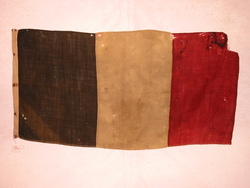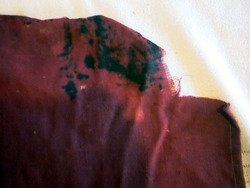French National Flag - Captain Paul Boynton.
The Tricolor of France is one of the best-known and most inspirational national flags in history. Members of the Paris militia wore blue and red ribbons in 1789 because they were the city colors. The king wore a cockade of white, the royal color. Lafayette, the commander of the National Guard, handed the Parisian ribbons to the king who added them to his cockade.
The three colors combined came to be associated with liberty during the French Revolution on clothing, banners, chinaware, printed material, and in flags. Finally in 1794 the modern tricolor was adopted for use on ships and, with added inscriptions and decorations, on military colors. It continued in use until 1815 when the French monarchy was restored. The Tricolor has been the national flag of France since 1830 except for a period of one month in 1848. It has inspired many other national flags in Europe and around the world.
This flag was found in the De Young collection after an auction but initial examination of records could not give any information on the flag. It appears to be from the 19th century possibly towards the end of the century. The cravat ZFC0207 also in the De Young sub collection seem to be a companion piece. Quiet possibly a French flag from the N. Africa colonial days related to the French Foreign Legion. This flag is in fair condition, suffering from slight discoloration and minor damage around the top fly corner. It is made from cotton and is hand-stitched.
This flag is credited to Captain Paul Boynton. Captain Paul introduced the initial notion of amusement "park" in 1897 when he opened a collection of attractions called "Sea Lion Park." While the popular idea that Boynton's park at Coney Island was the first amusement park, historian Stan Barker states that Boynton had a similar park, complete with chutes in Chicago. He claims that this park helped to jump-start the Coney Island growth and that Boyton revolutionized the industry on July 4th, 1894 when he opened Paul Boynton's Water Chutes-the world's first park.
ZFC Significant Flag
Sources:
History of the de Young Museum, de Young, Fine Arts Museums of San Francisco, 16 November 2011:
http://deyoung.famsf.org/about/history-de-young-museum
Paul Boyton, Wikipedia, 16 November 2011, from:
http://en.wikipedia.org/wiki/Paul_Boyton
Paul Boynton; Inventor and Showman 'The Fearless Frogman', The Mighty Miss, 16 November 2011, from:
http://www.msnbc.msn.com/id/5581050/ns/news-the_mighty_miss/t/paul-boynton-inventor-showman/#.TsW4CXJVUqx
Stanton, Jeffrey, Coney Island - Sea Lion Park, 16 November 2011, from: http://www.westland.net/coneyisland/articles/sealionpark.htm





















